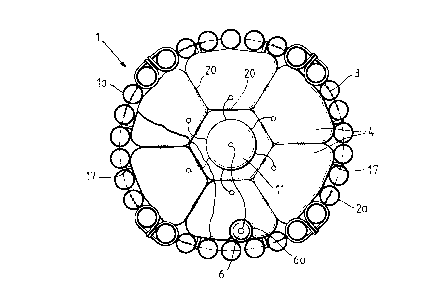Some of the information on this Web page has been provided by external sources. The Government of Canada is not responsible for the accuracy, reliability or currency of the information supplied by external sources. Users wishing to rely upon this information should consult directly with the source of the information. Content provided by external sources is not subject to official languages, privacy and accessibility requirements.
Any discrepancies in the text and image of the Claims and Abstract are due to differing posting times. Text of the Claims and Abstract are posted:
| (12) Patent: | (11) CA 2001236 |
|---|---|
| (54) English Title: | FASCINE |
| (54) French Title: | FASCINE |
| Status: | Expired and beyond the Period of Reversal |
| (51) International Patent Classification (IPC): |
|
|---|---|
| (72) Inventors : |
|
| (73) Owners : |
|
| (71) Applicants : | |
| (74) Agent: | SMART & BIGGAR LP |
| (74) Associate agent: | |
| (45) Issued: | 1999-02-09 |
| (22) Filed Date: | 1989-10-23 |
| (41) Open to Public Inspection: | 1990-04-24 |
| Examination requested: | 1996-10-18 |
| Availability of licence: | N/A |
| Dedicated to the Public: | N/A |
| (25) Language of filing: | English |
| Patent Cooperation Treaty (PCT): | No |
|---|
| (30) Application Priority Data: | ||||||
|---|---|---|---|---|---|---|
|
A fascine 1 suitable for filling ditches includes a core
comprising a plurality of inflatable core members 4, and a sleeve 2a
comprising a multiplicity of axially parallel sleeve members 1a
connected by at least two flexible tie means 3 such as chains. A
compressed gas cylinder 6 is provided for inflating the core, and is
connected to the core members 4 by a ring main manifold 11
incorporating one way valves for allowing gas to flow into the core
members only.
The invention also provides a plurality of fascines in
combination with a launching means.
Fascine (1) utilisée pour combler des fossés. La fascine inclut un noyau à plusieurs éléments gonflables (4), et une enveloppe (2a) comprenant plusieurs éléments parallèles axiaux (1a) raccordés par au moins deux dispositifs de liaison flexibles (3) comme des chaînes. Une bouteille à gaz comprimé (6) permet de gonfler le noyau, et est raccordée aux éléments (4) du noyau par un manifold principal annulaire (11) incorporant des soupapes unidirectionnelles pour permettre au gaz de s'écouler dans les éléments du noyau seulement. L'invention présente également plusieurs fascines en combinaison avec un dispositif de lancement.
Note: Claims are shown in the official language in which they were submitted.
Note: Descriptions are shown in the official language in which they were submitted.

2024-08-01:As part of the Next Generation Patents (NGP) transition, the Canadian Patents Database (CPD) now contains a more detailed Event History, which replicates the Event Log of our new back-office solution.
Please note that "Inactive:" events refers to events no longer in use in our new back-office solution.
For a clearer understanding of the status of the application/patent presented on this page, the site Disclaimer , as well as the definitions for Patent , Event History , Maintenance Fee and Payment History should be consulted.
| Description | Date |
|---|---|
| Inactive: IPC from MCD | 2006-03-11 |
| Inactive: IPC from MCD | 2006-03-11 |
| Inactive: IPC from MCD | 2006-03-11 |
| Time Limit for Reversal Expired | 2005-10-24 |
| Letter Sent | 2004-10-25 |
| Letter Sent | 2004-03-30 |
| Inactive: Correspondence - Transfer | 2004-03-23 |
| Inactive: Correspondence - Transfer | 2004-03-15 |
| Inactive: Correspondence - Transfer | 2004-01-13 |
| Inactive: Office letter | 2003-11-17 |
| Inactive: Correspondence - Transfer | 2003-10-21 |
| Letter Sent | 2003-10-21 |
| Grant by Issuance | 1999-02-09 |
| Pre-grant | 1998-08-10 |
| Inactive: Final fee received | 1998-08-10 |
| Inactive: Received pages at allowance | 1998-07-03 |
| Letter Sent | 1998-02-16 |
| Notice of Allowance is Issued | 1998-02-16 |
| Notice of Allowance is Issued | 1998-02-16 |
| Inactive: Application prosecuted on TS as of Log entry date | 1998-02-09 |
| Inactive: Status info is complete as of Log entry date | 1998-02-09 |
| Inactive: IPC assigned | 1998-02-04 |
| Inactive: IPC removed | 1998-02-04 |
| Inactive: First IPC assigned | 1998-02-04 |
| Inactive: Approved for allowance (AFA) | 1998-01-02 |
| All Requirements for Examination Determined Compliant | 1996-10-18 |
| Request for Examination Requirements Determined Compliant | 1996-10-18 |
| Application Published (Open to Public Inspection) | 1990-04-24 |
There is no abandonment history.
The last payment was received on
Note : If the full payment has not been received on or before the date indicated, a further fee may be required which may be one of the following
Please refer to the CIPO Patent Fees web page to see all current fee amounts.
| Fee Type | Anniversary Year | Due Date | Paid Date |
|---|---|---|---|
| MF (application, 8th anniv.) - standard | 08 | 1997-10-23 | 1997-09-22 |
| Final fee - standard | 1998-08-10 | ||
| MF (application, 9th anniv.) - standard | 09 | 1998-10-23 | 1998-09-21 |
| MF (patent, 10th anniv.) - standard | 1999-10-25 | 1999-09-15 | |
| MF (patent, 11th anniv.) - standard | 2000-10-23 | 2000-09-13 | |
| MF (patent, 12th anniv.) - standard | 2001-10-23 | 2001-09-14 | |
| MF (patent, 13th anniv.) - standard | 2002-10-23 | 2002-09-11 | |
| Registration of a document | 2003-09-02 | ||
| MF (patent, 14th anniv.) - standard | 2003-10-23 | 2003-09-15 | |
| MF (application, 2nd anniv.) - standard | 02 | 1991-10-23 |
Note: Records showing the ownership history in alphabetical order.
| Current Owners on Record |
|---|
| QINETIQ LIMITED |
| Past Owners on Record |
|---|
| DEREK IAN KNIGHT |